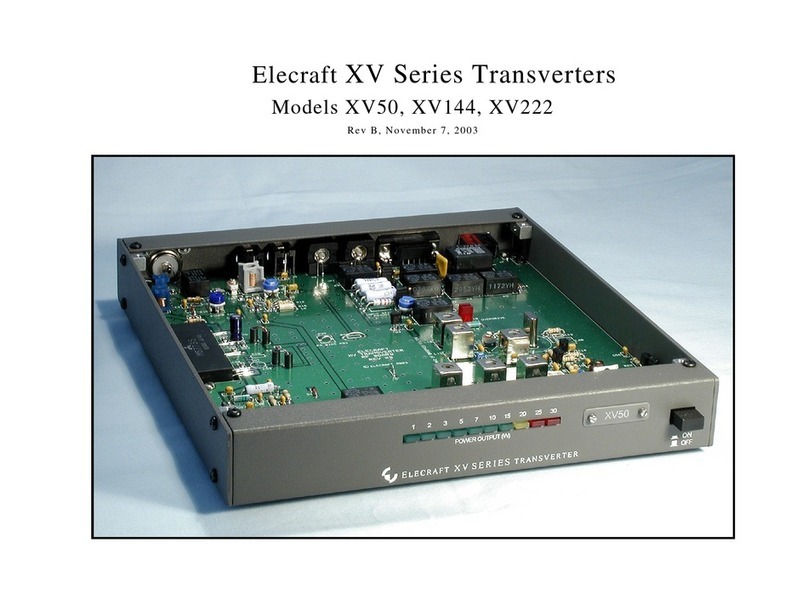
- 1 -
Introduction
This is the assembly manual for the Elecraft XV432 transverter kit. A
separate manual covers the assembly of the Elecraft XV50, XV144 and
XV222 transverters.
Full details of the Elecraft transverters including specifications,
installation, operation, circuit descriptions, options, troubleshooting and
maintenance instructions are included in the Owner’s Manual which
accompanies this kit.
This is an intermediate-to-advanced kit, yet you'll be surprised at how
uncomplicated it is to build. All of the radio frequency (RF) circuits are on
one printed circuit board (PCB). A second smaller PCB holds the
microcontroller and front-panel LEDs. High-quality, double-sided PCBs
are used, with plated-through holes for optimal RF performance. Point-to-
point wiring is minimal. All components to be installed have wire leads;
the few surface-mount devices required are pre-installed on the PCB.
Customer Service and Support
Whether you build the kit or buy a factory-built transverter, you’ll find a
wealth of information on our web site at www.elecraft.com. Among the
materials there you’ll find the latest application notes, photographs, any
updates to this manual, and information on new products. We also have a
popular e-mail forum, for which you can sign up from the web site. It's a
great way to interact with other Elecraft owners, exchange ideas and find
answers to many questions.
You can also get assistance by telephone or by sending an e-mail to
record of your question. Telephone assistance is available from 9 A.M. to
5 P.M. Pacific time, Monday through Friday (except US Holidays) at 831-
662-8345.
Repair Service
Contact Elecraft before returning your equipment to obtain the current
information on repair fees and the address where you should ship your
unit.
To ship the unit, first seal it in a plastic bag to protect the finish. Use a
sturdy packing carton with at least 3-in (8 cm) of foam or shredded paper
on all sides. Seal the package with reinforced tape. (Neither Elecraft or the
carrier will accept liability for damage due to improper packaging.)
Elecraft 1-Year Limited Warranty
If building a kit, complete the assembly, carefully following all instructions
in the manual, before requesting warranty service.
What is covered: During the first year after the date of first consumer
purchase, Elecraft will replace defective parts free of charge (post-paid).
We will also correct any malfunction caused by defective parts and
materials. You must send the unit at your expense to Elecraft. We will pay
return shipping.
What is not covered: This warranty does not cover correction of assembly
errors or misalignment; repair of damage caused by misuse, negligence or
builder modifications; or any performance malfunctions involving non-
Elecraft accessory equipment. The use of acid-core solder or any
corrosive or conductive flux or solvent will void this warranty in
its entirety.Also not covered is any reimbursement for loss of use,
inconvenience, customer assembly or alignment time, or cost of
unauthorized service.
Limitation of incidental or consequential damages: This warranty does
not extend to non-Elecraft equipment or components used in conjunction
with our products. Any such repair or replacement is the responsibility of
the customer. Elecraft will not be liable for any special, indirect, incidental
or consequential damages, including but not limited to any loss of
businesses or profits.




























